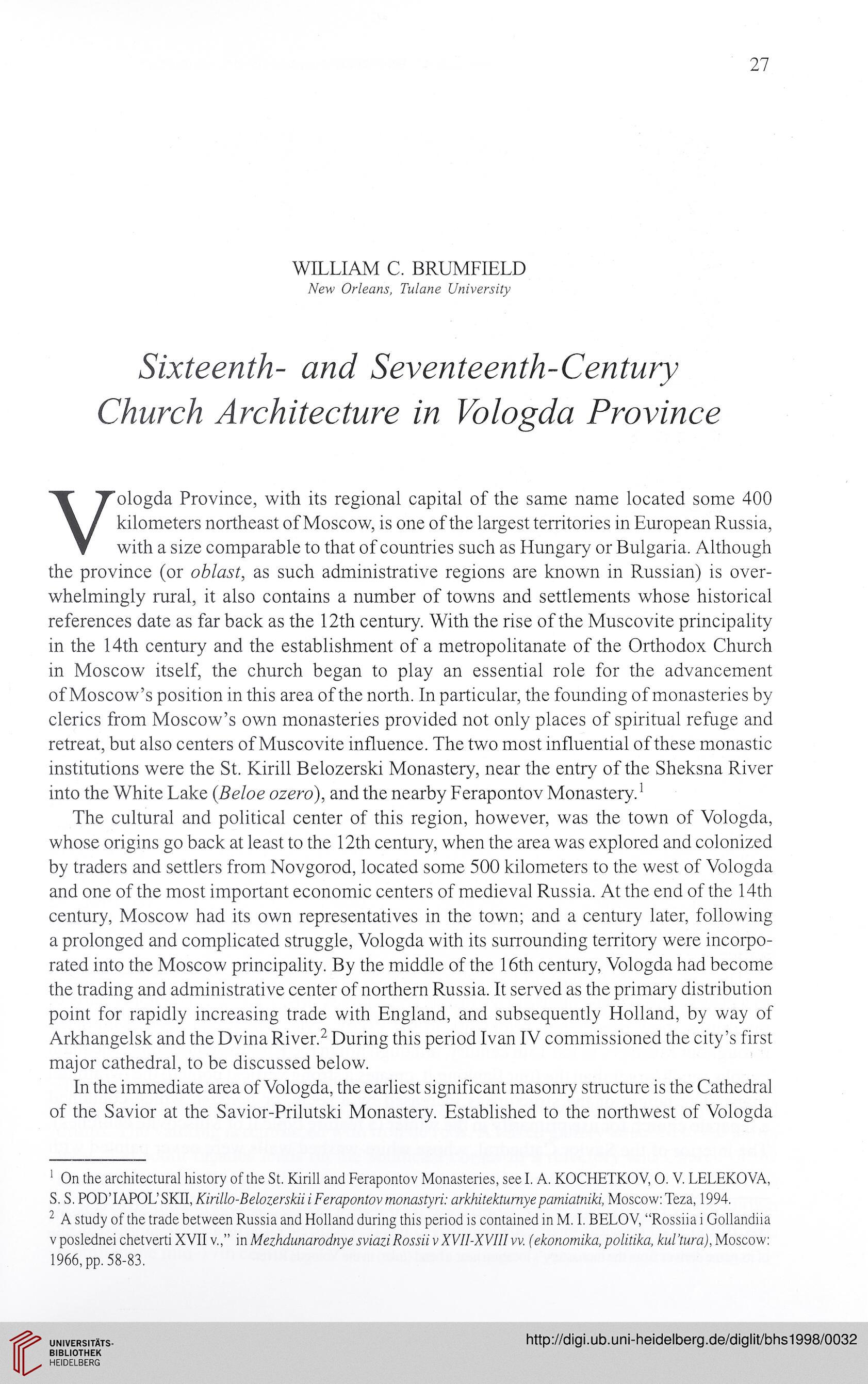27
WILLIAM C. BRUMFIELD
New Orleans, Tulane Uniyersity
Sixteenth- and Seyenteenth-Century
Church Architecture in Yologda Province
Vologda Province, with its regional Capital of the same name located some 400
kilometers northeast of Moscow, is one of the largest territories in European Russia,
with a size comparable to that of countries such as Hangary or Bułgaria. Although
the province (or obłast, as such administrative regions are known in Russian) is over-
whelmingly rural, it also contains a number of towns and settlements whose histoncal
references datę as far back as the 12th century. With the rise of the Muscovite pnncipality
in the 14th century and the establishment of a metropolitanate of the Orthodox Church
in Moscow itself, the church began to play an essential role for the advancement
of Moscow’s position in this area of the north. In particular, the founding of monasteries by
clerics from Moscow’s own monasteries provided not only places of spiritual refuge and
retreat, but also centers of Muscovite influence. The two most influential of these monastic
institutions were the St. Kirill Belozerski Monastery, near the entry of the Sheksna River
into the White Lakę (Beloe ozero), and the nearby Ferapontov Monastery.1
The cultural and political center of this region, however, was the town of Vologda,
whose origins go back at least to the 12th century, when the area was explored and colonized
by traders and settlers from Novgorod, located some 500 kilometers to the west of Vologda
and one of the most important economic centers of medieval Russia. At the end of the 14th
century, Moscow had its own representatives in the town; and a century later, foliowing
a prolonged and complicated struggle, Vologda with its surrounding territory were incorpo-
rated into the Moscow principality. By the middle of the 16th century, Yologda had become
the trading and administrative center of northern Russia. It served as the primary distribution
point for rapidly increasing trade with England, and subseąuently Holland, by way of
Arkhangelsk and the Dvina River 2 During this period Ivan IV commissioned the city’s first
major cathedral, to be discussed below.
In the immediate area of Vologda, the earliest significant masonry structure is the Cathedral
of the Savior at the Savior-Prilutski Monastery. Established to the northwest of Yologda
1 On the architectural history of the St. Kirill and Ferapontov Monasteries, see I. A. KOCHETKOV, O. V. LELEKOYA,
S. S. POD’IAPOL’SKII, Kirillo-Belozerskii i Ferapontovmonastyri: arkhitektumyepamiatniki, Moscow: Teza, 1994.
2 A study of the trade between Russia and Holland during this period is contained in M. I. BELOV, “Rossiia i Gollandiia
vposlednei chetverti XVII v.,” in Mezhdunarodnye sviaziRossiiy XVII-XVIII w. (ekonomika, politika, kul’tura), Moscow:
1966, pp. 58-83.
WILLIAM C. BRUMFIELD
New Orleans, Tulane Uniyersity
Sixteenth- and Seyenteenth-Century
Church Architecture in Yologda Province
Vologda Province, with its regional Capital of the same name located some 400
kilometers northeast of Moscow, is one of the largest territories in European Russia,
with a size comparable to that of countries such as Hangary or Bułgaria. Although
the province (or obłast, as such administrative regions are known in Russian) is over-
whelmingly rural, it also contains a number of towns and settlements whose histoncal
references datę as far back as the 12th century. With the rise of the Muscovite pnncipality
in the 14th century and the establishment of a metropolitanate of the Orthodox Church
in Moscow itself, the church began to play an essential role for the advancement
of Moscow’s position in this area of the north. In particular, the founding of monasteries by
clerics from Moscow’s own monasteries provided not only places of spiritual refuge and
retreat, but also centers of Muscovite influence. The two most influential of these monastic
institutions were the St. Kirill Belozerski Monastery, near the entry of the Sheksna River
into the White Lakę (Beloe ozero), and the nearby Ferapontov Monastery.1
The cultural and political center of this region, however, was the town of Vologda,
whose origins go back at least to the 12th century, when the area was explored and colonized
by traders and settlers from Novgorod, located some 500 kilometers to the west of Vologda
and one of the most important economic centers of medieval Russia. At the end of the 14th
century, Moscow had its own representatives in the town; and a century later, foliowing
a prolonged and complicated struggle, Vologda with its surrounding territory were incorpo-
rated into the Moscow principality. By the middle of the 16th century, Yologda had become
the trading and administrative center of northern Russia. It served as the primary distribution
point for rapidly increasing trade with England, and subseąuently Holland, by way of
Arkhangelsk and the Dvina River 2 During this period Ivan IV commissioned the city’s first
major cathedral, to be discussed below.
In the immediate area of Vologda, the earliest significant masonry structure is the Cathedral
of the Savior at the Savior-Prilutski Monastery. Established to the northwest of Yologda
1 On the architectural history of the St. Kirill and Ferapontov Monasteries, see I. A. KOCHETKOV, O. V. LELEKOYA,
S. S. POD’IAPOL’SKII, Kirillo-Belozerskii i Ferapontovmonastyri: arkhitektumyepamiatniki, Moscow: Teza, 1994.
2 A study of the trade between Russia and Holland during this period is contained in M. I. BELOV, “Rossiia i Gollandiia
vposlednei chetverti XVII v.,” in Mezhdunarodnye sviaziRossiiy XVII-XVIII w. (ekonomika, politika, kul’tura), Moscow:
1966, pp. 58-83.




